Just because landscapes are full of greenery doesn’t automatically make them “green”. Sustainable landscaping is about designing outdoor spaces that work with nature, not against it.
As a designer or builder, you have the power to create eco-friendly landscape designs that are functional, cost-effective and beautiful. So how can you achieve that balance?
In this 7-minute read, we’ll give you… that make your landscape designs….
- 10 smart strategies for more sustainable landscaping
- Expert tips for implementing each in your designs
- A way to streamline your design process
10 Ideas to Make Your Landscape Design More Sustainable
When it comes to sustainable landscaping, the goal is simple — create outdoor spaces that require minimal resources and support the environment. Regardless of the landscape style you’re going for, here are 10 expert-backed ideas that can help you design eco-friendly, functional landscapes that last.
1. Erosion Control
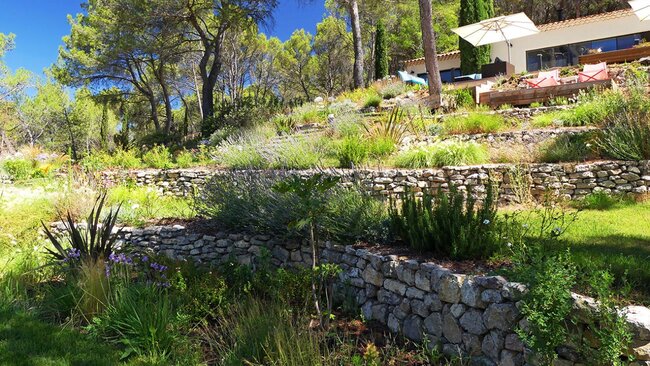
How this idea increases sustainability:
Erosion control plays a critical role in protecting your soil and reducing stormwater runoff. When you prevent soil erosion, you’re preserving essential nutrients in the soil. This leads to healthier plants and less reliance on chemical fertilizers.
How to add erosion control into your landscape designs:
- Choose native groundcovers: Native plants like creeping thyme or clover aren’t just pretty — they’re powerhouses for erosion control. They form a living mulch which naturally protects your soil and requires very little water once established.
- Build terraces on slopes: Terracing isn’t just functional, it also adds unique visual interest. By creating flat areas on slopes, you slow water flow so it can seep into the flat areas instead of washing soil away. This reduces runoff and keeps moisture where you need it.
- Go for permeable hardscapes: Using materials like decomposed granite or permeable pavers helps water penetrate the soil instead of running off into storm drains.
2. Native Plants
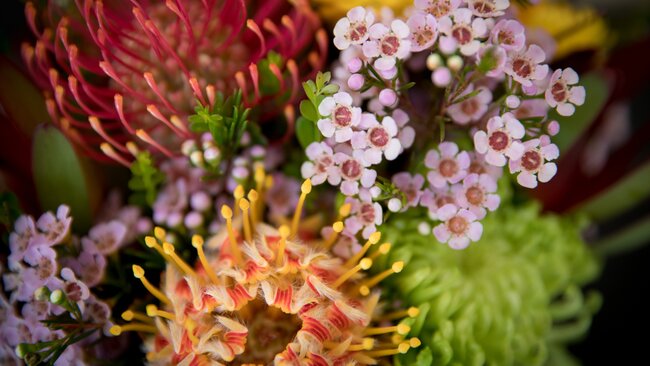
How this idea increases sustainability:
Native plants are the unsung heroes of sustainable landscaping. Since they’ve adapted to the local climate, soil and insects, they’re often drought-tolerant and resilient. This helps create a low maintenance landscape that doesn’t rely on chemical fertilizers or constant watering. Plus, it supprts local wildlife habitats and beneficial organisms like pollinators.
How to add native plants into your green landscaping designs:
- Select plants adapted to local climate conditions: Choose native species that are naturally adapted to your region’s rainfall, temperature fluctuations and soil types. For example, in arid regions, plants like sagebrush and manzanita are ideal for low-water landscapes.
- Boost biodiversity: Choose a variety of native plants to attract local pollinators like bees and butterflies. This improves the beauty of the landscape and also creates a self-sustaining ecosystem that requires less maintenance.
- Minimize the risk of invasive species: Non native plants have the potential to introduce invasive, non-native species that could outcompete local vegetation and disrupt ecosystems.
3. Rain Harvesting
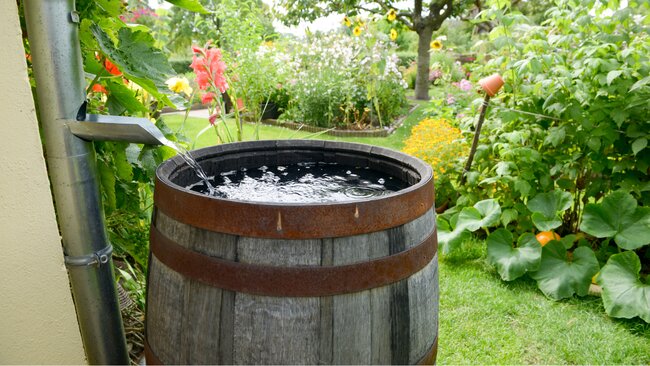
How this idea increases sustainability:
Rain harvesting is one of the most practical ways to conserve water in your landscape. By collecting and storing rainwater, you can reduce your dependence on municipal water and keep your landscape thriving during dry spells. Plus, using stored rainwater is a win-win for your clients as well since it helps manage stormwater runoff and reduces their water bills.
How to add rain harvesting into your green landscaping designs:
- Set up rain barrels: Install rain barrels at the base of downspouts to capture runoff from your roof. Place like Lowes and Home Depot have simple rain barrels with mesh tops that filter out debris and spigots where you can connect a hose of fill up a watering can.
- Design a rain garden and other rainwater infiltration systems: A rain garden is an area of native plants that are planted in a small depression, often on a slope. They not only capture runoff but also filter it through plant roots to improve plant health and soil quality. Add bioswales to manage overflow during heavy rains. These capture excess water and give it a place to slowly seep into the ground.
- Incorporate gravity-fed drip irrigation: Use the stored rainwater in a drip irrigation system to water plants more efficiently. The irrigation heads on this system deliver water directly to the roots to reduce waste and make sure your plants get exactly what they need. And gravity-fed systems don’t rely on pumps, so you’re also reducing the energy needs of the landscape.
- Install multi-barrel systems or underground rainwater storage for larger landscapes: For larger residential or commercial projects, consider using a multi-barrel system or underground rainwater storage tanks connected to downspouts from roofs or other surfaces.
For reference, a commercial building with a 4000 square foot roof can easily collect over 2000 gallons of water with just 1 inch of rain. Depending on the amount of rain your area gets per year and the cost of water and sewer, that could add up to hundreds or even thousands of dollars of savings per year!
You can then connect this water storage to irrigation systems so you use less municipal water. Plus this also greatly limits the amount of water entering local storm drains.
4. Solar-Powered Landscape Lighting
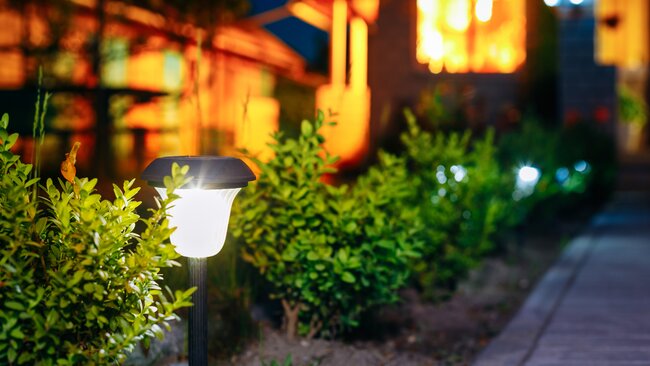
How this idea increases sustainability:
Solar-powered landscape lighting is a fantastic way to combine aesthetics and energy efficiency. By using the sun’s energy to power your lights, you’re cutting down on electricity use and reducing carbon emissions.
How to add solar-powered landscape lighting into your landscape designs:
- Place lights where they’ll get full sun: This may sound obvious, but making sure your solar panels are positioned where they’ll soak up sunlight during the day is important. So try to avoid spots that are constantly shaded by trees or buildings.
- Go with smart solar lights with motion sensors: Choose solar lights with built-in motion sensors to save energy and extend battery life. These lights only turn on when needed or have a dim mode and bright mode that activates when it senses motion.
TIP! – Want to see how your landscape will look at night with realistic lighting effects? Use Contemporary Style Design 3D software to create landscape designs you and your clients can visualize at different times of the day.
5. Compost Station
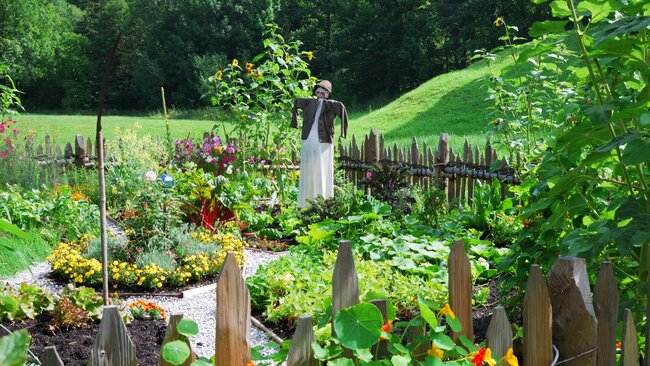
How this idea increases sustainability:
A compost station is one of the easiest ways to recycle organic waste like grass clippings and vegetable scraps. Instead of sending this material to the landfill, where it contributes to greenhouse gas emissions, why not use it to create nutrient-rich compost to create healthy soil that helps your plants thrive without chemical fertilizers?
How to add a compost station into your landscape designs:
- Pick a practical spot: Ideally, the compost bin should be near your garden or flower beds, so you don’t have to haul the compost too far when it’s ready. Try to tuck it into a spot that’s out of sight but still easy to access.
- Balance your compost mix: A good compost pile needs a mix of green organic material (grass clippings, vegetable peels) and brown organic matter (leaves, wood chips). Avoid adding meat or dairy products since these can attract pests. Educate clients about what types of yard waste can go into compost. Make sure they only use pest free plant materials, since diseased plants will spread plant pests within the garden.
- Use multiple bins: A multi-bin system keeps the composting process organized. You can have one bin for fresh waste, one for active composting and another for fully finished compost that’s ready to go in the flower or vegetable garden.
6. Permeable Hardscapes
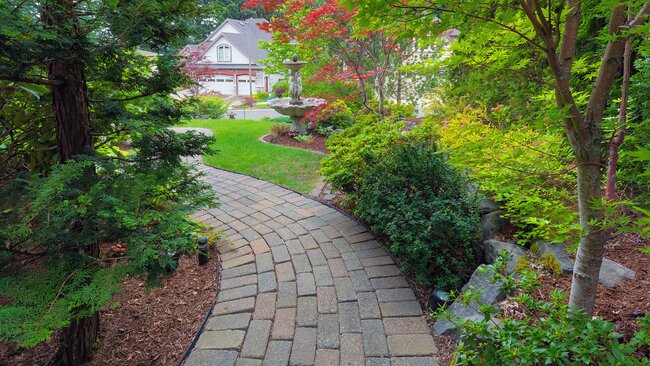
How this idea increases sustainability:
Unlike large areas of concrete and asphalt, a permeable hardscape helps manage stormwater runoff by allowing water to filter through the surface and into the ground. This reduces flooding, prevents erosion and replenishes groundwater.
How to add permeable hardscapes into your landscape designs:
- Choose materials like gravel or porous pavers: They let rainwater seep through and are a nice choice for walkways, patios and driveways.
- Use different textures and materials for optimal drainage: Combine permeable materials to enhance both aesthetics and functionality. For example, create pathways using a combination of pavers and gravel.
- Design for water catchment: When designing patios, driveways, or walkways, grade the surfaces slightly so that water naturally flows toward areas where it can be absorbed, such as rain gardens or planted areas.
- Incorporate subsurface drainage: This could include a bed of coarse gravel or a perforated pipe system that channels excess water into stormwater drains or rain gardens.
7. Xeriscaping

How this idea increases sustainability:
Xeriscaping is all about designing landscapes that need minimal water. It focuses on drought-tolerant plants and minimizing water evaporation and runoff to reduce or eliminate the need for irrigation even in dry climates.
How to add xeriscaping into your landscape designs:
- Create hydrozones for water efficiency: Group plants with similar water needs together in specific zones. This helps you tailor your irrigation efforts and avoid overwatering certain areas.
- Go with drought-tolerant plants: Choose plants like succulents, lavender or native grasses that can withstand dry conditions.
- Select soil amendments that boost water retention: In areas where soil is dry or sandy, add organic materials like compost or biochar to increase the soil’s capacity to hold moisture.
- Mulch for moisture: Apply mulch around your xeriscape plants to maintain soil moisture, reduce evaporation and suppress weeds.
8. Rock Garden
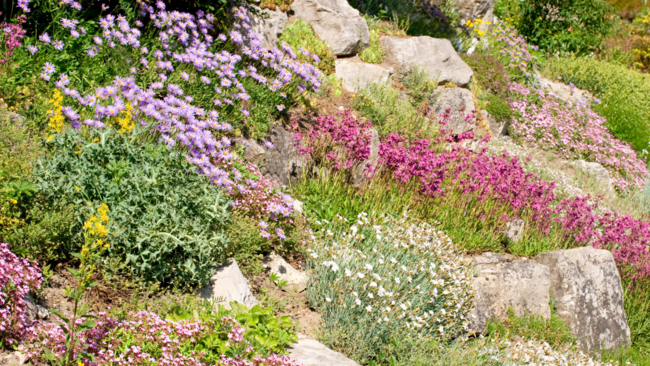
How this idea increases sustainability:
By using rocks and drought-tolerant plants, you can significantly cut down on water usage. Plus, rock gardens naturally prevent soil erosion and require minimal maintenance, so they’re an eco-friendly choice for sustainable landscapes.
How to add a rock garden to your sustainable garden designs:
- Create natural drainage: Use the rocks strategically to direct water where it’s needed. For instance, setting up a dry creek bed can help manage rainwater runoff and prevent water from pooling in unwanted areas.
- Use local stone: Try to choose rocks from nearby quarries or suppliers to reduce transportation emissions and ensure that the materials will blend seamlessly with the surrounding environment.
- Combine varying rock sizes for visual interest and functionality: Use a mix of large boulders, medium-sized rocks and gravel to create layers in the rock garden.
9. Wildlife Garden
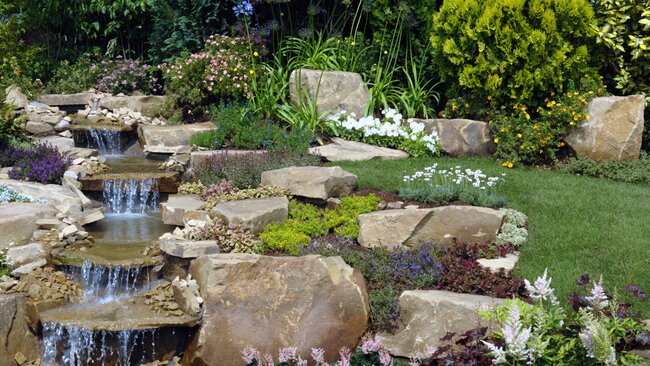
How this idea increases sustainability:
A wildlife garden turns your sustainable landscape design into an ecological haven. By planting native species that attract pollinators and other beneficial organisms, you’re supporting local ecosystems. A wildlife habitat also promotes biodiversity, helps with natural pest control and even improves plant health.
How to add a wildlife garden to your green landscaping designs:
- Plant for pollinators: Include native flowers like coneflowers, milkweed and black-eyed Susans that attract bees, butterflies and birds.
- Add water features: Wildlife needs water. That’s why even a simple birdbath or small pond attracts a lot of wildlife.
- Install nesting boxes and insect hotels: Add man-made structures like birdhouses, bat boxes or insect hotels to provide shelter for local wildlife. Things like these give animals and insects safe places to nest and thrive in an otherwise human-dominated landscape.
10. Use Local Materials
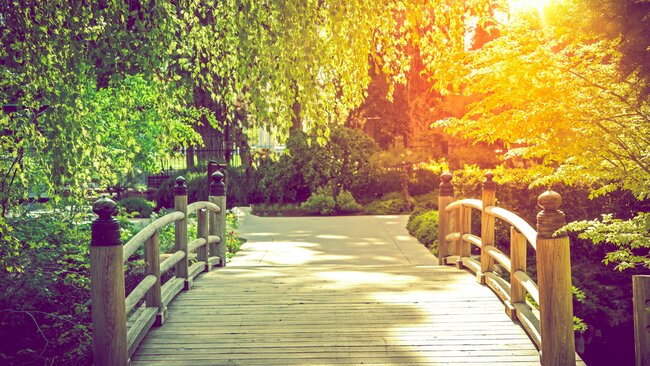
How this idea increases sustainability:
Local materials often have a smaller carbon footprint because they don’t require long-distance transportation. Plus, they’re typically more durable in the local climate, so your landscape is more resilient in the long run.
How to add local materials to your landscape designs:
- Source building materials locally: Look for regionally available materials, like stone from nearby quarries or reclaimed local timber,
- Choose native plants: Incorporating native plants is another way to use “local” resources.
- Minimize synthetic materials: Reduce reliance on non-renewable, synthetic materials by using locally sourced alternatives like wood chips or gravel for paths and groundcover. This makes the landscape more natural and also reduces its overall carbon footprint.
Start Including Sustainable Features In Your Designs Today
It’s easy to see why green landscaping is so important! Incorporating sustainable practices like conserving water, proper plant selection, and integrated pest management helps reduce maintenance costs while creating functional, eco-friendly spaces. Using native plants, a rain garden, permeable hardscapes and sub-surface irrigation promotes water conservation and healthy, organic soil. Even features like shade trees on the north and west sides of a building, along with deciduous trees for summer shade, can improve energy efficiency.
Contemporary Style Design makes it easy to design landscapes that are both cost-efficient and environmentally sustainable. With Contemporary Style Design, you can:
- Create realistic 3D visualizations that show vegetable gardens, wildlife habitats, evergreen trees and more
- Intelligent and easy to use design tools that let you create custom landscape designs faster than ever
- Photorealistic renderings let you see the landscape in a variety of realistic lighting environments
With a FREE version, you’ve got nothing to lose. Try Contemporary Style Design today!




